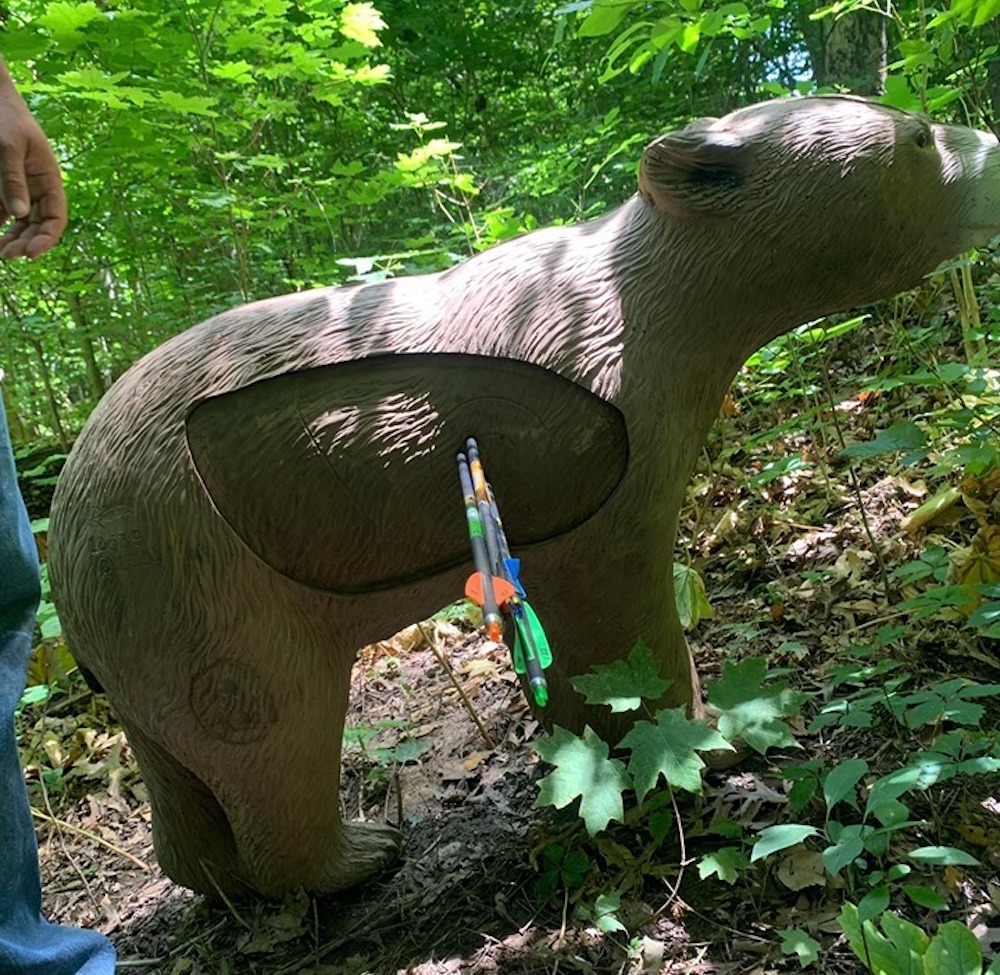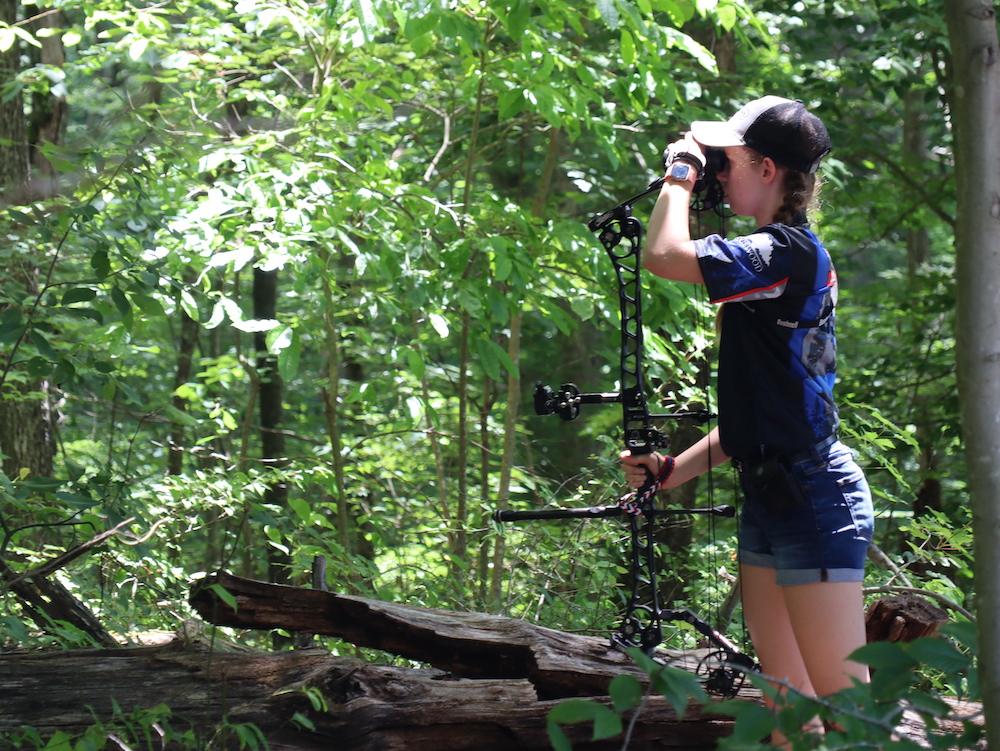What is 3D archery? It’s a game played by walking a preset course — usually in the woods — and shooting at three-dimensional, foam animal targets at varying distances. Depending on the rules governing a particular shoot, those distances might be either known or unknown.
In the known game, rangefinders are allowed to measure the distance to a target. In the unknown game, it’s up to the archer to guess the distance, which adds an additional challenge.
For the most part, the maximum distance you’ll shoot in a 3D competition is 50 yards. There are divisions for kids, novices, barebow archers and Olympic recurve archers, however, that cap the shooting distance at 30, 40 or 45 yards. And then there are a few extreme-distance 3D shoots where archers might shoot out to 100 yards. We’ll stick to the 50-yard maximum shoots here.
The two primary 3D organizations in the U.S. are the Archery Shooters Association and the International Bowhunting Organization. Each has its rules and targets. ASA targets are all made by Delta McKenzie, and IBO targets are all made by Rinehart.
The targets imitate a variety of North American and African game animals. To name a few, you might see white-tailed deer, bears, bobcats, coyotes, Dall sheep, elk, leopards and alligators. One of the challenges is to identify precisely where the scoring rings are on each animal. Generally, they will be positioned where you’d expect to find the vital organs on the real animal the target is imitating. But the scoring rings are only etched into the target foam, rather than highlighted with a bright color, so they can be challenging to see in different lighting conditions.
In ASA scoring, a miss is worth zero points, a hit on the target body but outside the scoring rings is worth 5 points, and a hit within the largest, outermost scoring ring is worth 8 points. Within the 8-ring, a hit in the next-smaller ring is worth 10 points, and hits inside the two smallest rings within the 10-ring are worth 12 points. There are two 12-rings inside an ASA 10-ring. One sits high in the 10-ring, and the other sits low. The lower 12 is always in play, unless the archer calls for the upper 12. In that instance, only the upper 12 is worth 12 points.

In IBO scoring, you can earn 11, 10, 8, 5 or zero points. The rings and scoring match ASA until you get inside the 10-ring. On IBO targets, there is only one small ring inside the 10-ring, and it is positioned exactly in the middle of the 10. That ring is worth 11 points.
In ASA and IBO, the arrow only needs to touch a scoring ring to earn the points awarded by that ring. So an arrow can be almost entirely in the 8-ring but just touching the outer edge of the 10-ring, and that arrow would score a 10.
Just about any archery equipment can be used in ASA and IBO tournaments. The ASA has separate classes for archers shooting full target compound setups, bowhunting gear, barebow recurve, traditional recurve or Olympic recurve. IBO has the same, except for Olympic recurve, which could be used in the Bowhunter Open class.
The specific equipment rules for each organization by division vary. For ASA rules, click here. For IBO rules, click here.

When setting up your gear specifically for 3D archery, there are a couple of key things to consider. There are arrow-speed restrictions that vary by division. You can find those in the organizations’ rules. But you’ll want to be sure your arrows are flying under the speed limit for your class.
To check your arrow speed, you’ll need to access a chronograph. If your arrows are too fast, you can slow them down by switching to heavier arrows, or by reducing the bow’s draw weight. To speed up the arrows, do the reverse.
You might consider setting up the largest-diameter arrows that you can effectively shoot from your bow. Across the board, the fattest arrows allowed by both ASA and IBO measure 27/64 inch, commonly known as 27-diameter arrows. Using the fattest arrows allowed increases the chance they’ll clip a scoring ring. But even more important than having fat arrows is being able to hit where you’re aiming. And the arrow that flies truest from your bow might be smaller than a 27-diameter. Testing with different arrows will let you know what works best.
Being able to see the targets clearly is a big part of 3D archery, since courses are typically wooded and can often require shooting in dark conditions. Archers who shoot peep sights will want to be sure the peep is large enough to let sufficient light get to their eyes. Yes, smaller peep apertures allow for more precise aiming, but they also require more light to be able to see the target clearly. Finding a balance is key for 3D archery.
Same goes for scope lenses in the classes that allow them. You need to find the magnification that lets you see the target in dark conditions and also magnifies it enough so you can pinpoint where the scoring rings are located. The higher the lens power, the darker the targets will appear.
Because courses are set in the outdoors, you need to be able to shoot in all conditions — rain, wind, heat, uphill, downhill, sidehill. Typically, the only weather element that postpones a 3D tournament is lightning. Anything else, and it’s game on. You need to know how you and your equipment perform in various conditions and terrains.
ASA has divisions where target distances are both known and unknown. IBO offers only unknown-distance shooting.

In known-distance 3D archery, having a good rangefinder that accounts for uphill and downhill angles is critical. Such rangefinders will calculate cuts — yardage reductions — when shooting at an angle, which enables you to adjust your sight, or gauge your aiming point, accordingly.
In unknown 3D, you have to develop the skill of judging distance. Some archers look at the ground and visually map out incremental distances to a target. Some archers just look at the target and gauge distance by how big or small it looks. Some archers do both. The point is, spend at least as much time practicing judging distance as you do shooting your bow.
Carry a rangefinder with you all the time and guess the distance to things you encounter, then use the rangefinder to check your accuracy. Over time, you will improve your ranging skills.
Getting involved in 3D archery can be as simple or as complex as you want. You can shoot for fun, for hunting practice or as a serious competitor. Give it a try this weekend at a club near you.




